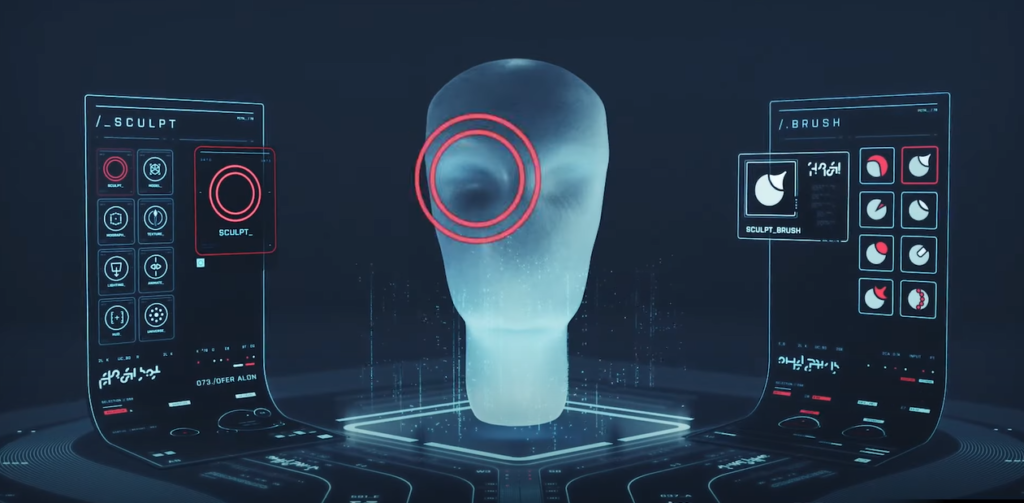The captivating world of 3D modeling, responsible for bringing us closer to the intricacies of real-life imaging and representation, has witnessed tremendous changes over the years. The game-changing factor in recent years has been the incorporation of Artificial Intelligence (AI). AI’s role in enhancing, automating, and revolutionizing the traditionally manual and often meticulous process of 3D modeling can’t be overstated.
Unpacking the Intersection of AI and 3D Modeling
AI’s impact on 3D modeling extends across a range of areas, most notably:
- Intelligent Automation;
- Data-Driven Decision Making;
- Personalized Design Elements.
Intelligent Automation
AI’s primary contribution to 3D modeling revolves around its ability to automate processes. Here are a few key areas:
- Image Recognition: AI’s ability to recognize and categorize shapes, patterns, and textures in an image enhances its usefulness in 3D modeling. This ability enables AI algorithms to generate accurate 3D models based on 2D image data;
| Tasks | Benefits |
|---|---|
| Object Detection | Identify and localize multiple objects in a single image. |
| Image Classification | Categorize the image content based on trained data. |
| Semantic Segmentation | Understand the role of each pixel in the image. |
- Modeling and Sculpting: AI aids in sculpting models by providing suggestions on proportions, symmetries, and geometries. It helps artists streamline their modeling process and improve their output quality;
| Tasks | Benefits |
|---|---|
| Tasks | Benefits |
| Proportional Suggestions | Achieve anatomical correctness and visual balance. |
| Symmetry Recommendations | Maintain consistency and harmony in the model. |
| Geometry Predictions | Save time by predicting the next logical step in the design. |
- Texture Generation: AI has made strides in generating textures based on simple descriptions or patterns in existing textures. This advancement reduces the manual effort required in creating and applying new textures.
| Tasks | Benefits |
|---|---|
| Texture Synthesis | Generate large-scale textures from small samples. |
| Texture Transfer | Apply the style of one texture onto another. |
| Material Suggestion | Recommend materials based on the texture properties. |
Data-driven Decision-making
The use of AI in 3D modeling extends beyond mere automation to offer intelligent, data-driven insights, improving the quality and relevance of designs:
- Performance Analysis: AI can analyze user interaction data with 3D models to optimize models based on user feedback, enhancing the end user experience;
| Tasks | Benefits |
|---|---|
| User Behavior Analysis | Understand how users interact with the 3D models. |
| Model Performance Tracking | Evaluate model performance across different parameters. |
| Feedback-Based Model Adjustment | Improve models based on user feedback and interaction data. |
- Trend Analysis: AI can evaluate data on emerging design trends, helping artists create relevant and innovative designs that resonate with the audience’s changing preferences.
| Tasks | Benefits |
|---|---|
| Trend Identification | Identify emerging design trends from various data sources. |
| Style Prediction | Predict future design trends based on current data. |
| Market Relevance | Maintain relevance in the design market with updated, trendy designs. |
Personalized Design Elements
One of the most exciting advancements in AI-driven 3D modeling is the ability to generate personalized design elements based on user preferences:
- Preference-Based Design: AI algorithms can track user design preferences over time and provide suggestions based on their unique style;
| Tasks | Benefits |
|---|---|
| User Preference Tracking | Understand the user’s unique style and preferences. |
| Style Recommendations | Recommend design elements aligned with the user’s style. |
| Personalized Model Generation | Generate 3D models tailored to the user’s preferences. |
- Adaptive Interfaces: AI-driven 3D modeling tools can adapt their interface based on user behavior, making the design process more intuitive and user-friendly.
| Tasks | Benefits |
|---|---|
| Interface Customization | Customize the interface based on user behavior and needs. |
| Tool Suggestions | Suggest tools and features based on the user’s past usage. |
| Learning-Based UI/UX Improvement | Improve user interface and experience based on learned user behavior. |
For better understanding of how these AI processes work in 3D modeling, check this video:
Pioneering AI Tools in 3D Modeling

Several trailblazing tools have adopted AI capabilities to streamline their 3D modeling processes, enhancing both the user experience and the final output. Here’s a list:
1. Pixologic’s ZBrush
ZBrush by Pixologic is a well-established tool in the world of 3D modeling and has been pioneering the adoption of AI for an enhanced user experience.
Key AI Features:
- AI-driven sculpting: ZBrush utilizes AI algorithms to improve its digital sculpting features. It observes user behavior and provides real-time guidance to help maintain proportions and symmetry. This adaptive feature reduces the learning curve and enables users to achieve their desired results more effectively;
- Predictive stroke analysis: ZBrush’s AI capabilities extend to analyzing and predicting the sculpting strokes, enabling a smoother and more intuitive user experience.
2. Adobe Substance Alchemist
Adobe’s Substance Alchemist is revolutionizing texture generation using the power of AI.
Key AI Features:
- AI-based texture generation: Alchemist allows users to create detailed and realistic textures from simple descriptions or existing textures. This feature, powered by AI, is extremely helpful for creating unique, high-quality textures without the need for extensive manual work;
- Smart Material Creation: The AI in Alchemist can analyze the environment of the 3D model and automatically suggest suitable materials, thus saving time and improving the overall design process.
3. NVIDIA’s GauGAN
GauGAN by NVIDIA is an AI-driven tool that stands out in the field of 3D modeling.
Key AI Features:
- Sketch to realistic images: One of the remarkable features of GauGAN is its ability to transform sketches into photorealistic images. This can be used to create detailed textures and backgrounds for 3D models, significantly enhancing the overall model visualization process;
- AI-based Image Refinement: GauGAN’s AI also assists in refining images and enhancing their details, further contributing to creating high-quality 3D models.
4. Dassault Systèmes’ CATIA
CATIA by Dassault Systèmes’ is a leading 3D modeling tool that has integrated AI for an improved design process.
Key AI Features:
- AI-based predictive modeling: CATIA offers predictive modeling capabilities powered by AI, which allow users to predict the future behavior of their models. This functionality can be instrumental in preventing design errors and optimizing the design process;
- AI-guided design suggestions: CATIA’s AI also suggests design enhancements based on the user’s modeling approach, which leads to a more optimized and efficient design process.
The Future Horizon – AI in 3D Modeling

The nexus of 3D modeling and Artificial Intelligence (AI) is brewing a revolutionary storm, poised to transcend the frontiers of design, gaming, and interactive environments. As AI algorithms grow more sophisticated, the creation of ultra-realistic models, AI-assisted animations, and highly personalized design environments is no longer a distant dream but an imminent reality.
Hyper-realistic Models
With the inception of advanced AI models, there is an unprecedented opportunity to generate 3D structures that mirror real-world objects with extraordinary accuracy. These hyper-realistic models stand to revolutionize a variety of industries:
- Film and Animation: Film directors and animators can use AI to craft realistic models and scenes, mitigating the need for costly physical sets and reducing production times;
- Video Games: Hyper-realistic models can transform the gaming industry by offering players an immersive experience that closely emulates the real world;
- Architecture: Architects can utilize AI to create detailed, life-like structures, improving their ability to visualize and communicate design ideas;
- Medical Education and Research: Medical professionals and students can use highly realistic 3D models for educational purposes and research.
AI-assisted Animation
In the animation domain, AI has enormous potential to automate portions of the animation process, in particular, producing lifelike movements and expressions:
- Movement Generation: AI can study and mimic real-life human or animal movements, allowing for smoother, more realistic animation. This can help reduce time-consuming manual animation work;
- Facial Expressions: AI can be trained to create accurate and believable facial expressions, adding depth to animated characters and making them more engaging;
- Voice Synthesis: By training on hours of dialogue, AI can help in synthesizing believable and unique voices for animated characters.
Personalized User Experience
The advent of AI in 3D modeling is not confined to professionals alone. It holds promise for end users, offering an innovative, personalized user experience that adapts to each user’s distinct style and requirements. Here are a few ways this could be implemented:
- Adaptive User Interfaces: AI can analyze user behavior to understand their preferences and then adapt the interface accordingly. This could mean rearranging tools, changing color schemes, or even suggesting frequently used actions;
- Automated Suggestions: AI can help users create better designs by suggesting improvements based on learned design principles and user preferences;
- Personalized Tutorials: AI can customize learning materials based on the user’s proficiency level, preferred learning style, and specific areas of interest.
Conclusion
The fusion of AI with 3D modeling is reshaping the landscape of 3D design. While AI is not yet able to replace human creativity, it acts as a powerful assistant, automating tedious tasks, providing insightful analyses, and personalizing the design process. The use of AI in 3D modeling has opened up exciting possibilities for the future, promising to transform the industry as we know it.
FAQ
AI plays a crucial role in automating manual tasks, analyzing data for insightful decision-making, and creating personalized design elements in 3D modeling.
While AI can assist and automate parts of the 3D modeling process, human intervention is still necessary, especially for creative and aesthetic decisions.
AI enhances user experience by offering personalized design suggestions, adaptive interfaces, and insightful performance and trend analyses.
